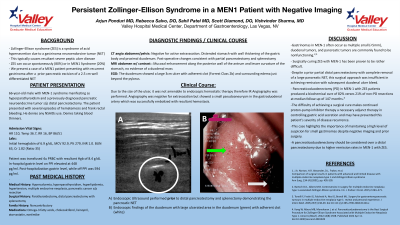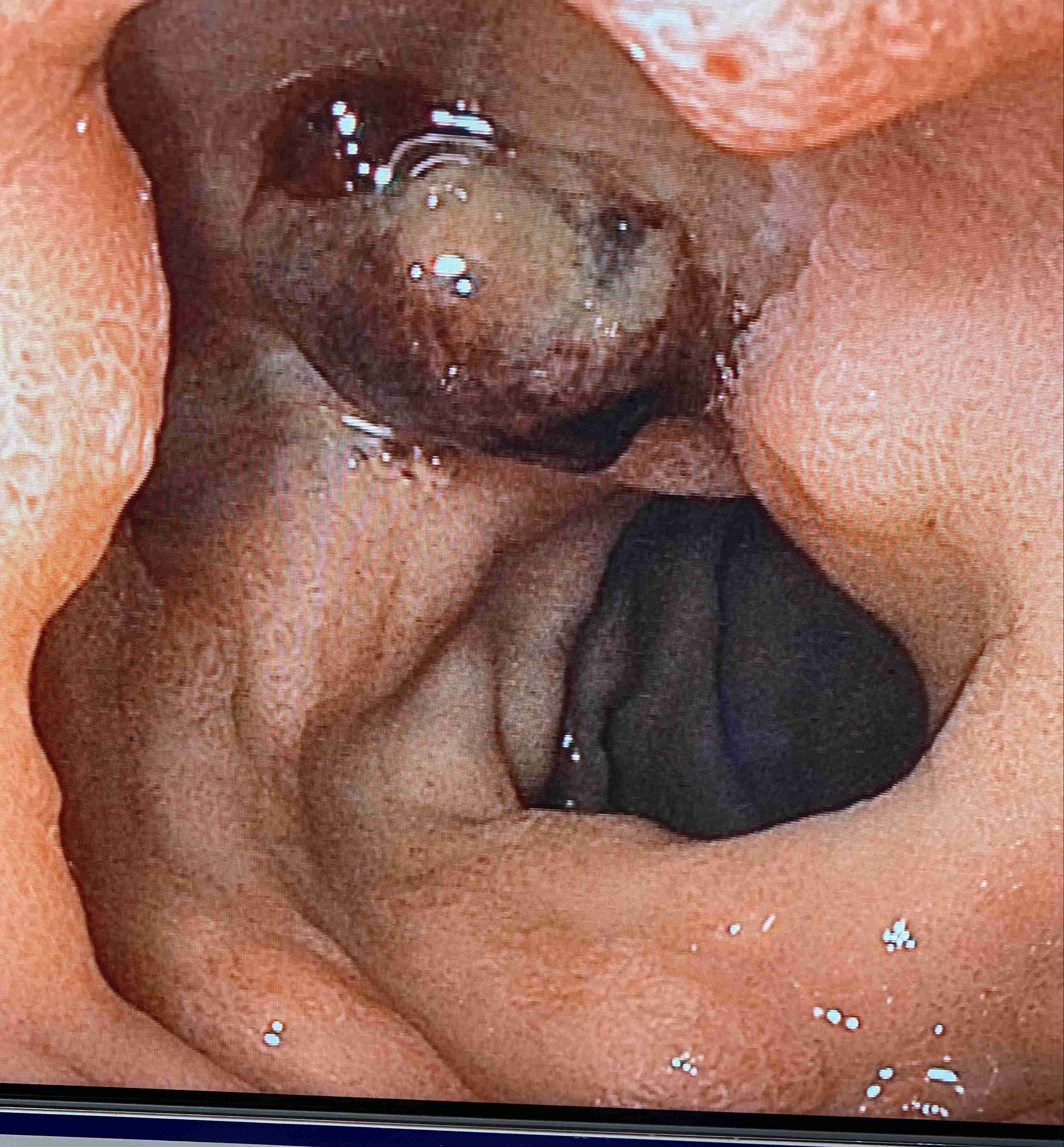Tuesday Poster Session
Category: GI Bleeding
P3507 - Persistent Zollinger-Ellison Syndrome in a MEN1 Patient After Pancreatic Excision
Tuesday, October 24, 2023
10:30 AM - 4:00 PM PT
Location: Exhibit Hall

Has Audio
- RS
Rebecca Salvo, DO
Valley Hospital Medical Center
Las Vegas, NV
Presenting Author(s)
Rebecca Salvo, DO1, Sahil Patel, MD2, Scott Diamond, DO1, Brian Carlson, MD1
1Valley Hospital Medical Center, Las Vegas, NV; 2Norton Healthcare, Louisville, KY
Introduction: Zollinger-Ellison syndrome (ZES) is a syndrome of acid hypersecretion with resultant severe peptic ulcer disease due to gastrinomas, which can occur spontaneously or in the Multiple Endocrine Neoplasia type 1 syndrome. We present a case of a MEN1 patient presenting with severe ZES despite undergoing prior pancreatic excision of a 2.5 cm well differentiated-neuroendocrine tumor.
Case Description/Methods: 66-year-old male with MEN1 syndrome, diagnosed upon workup for hypercalcemia with hyperparathyroidism and a 2.5 cm pancreatic body mass, presenting with hematochezia. 6 months prior, patient underwent exploratory laparotomy, extended distal pancreatectomy and lymph node biopsies for his pancreatic mass. Pancreatic mass biopsies returned well-differentiated neuroendocrine tumor. He was lost to follow-up.
The patient presented to our hospital with severe rectal bleeding, hematemesis with associated hemodynamic instability and a hemoglobin of 6.9 g/dl. CTA abdomen/pelvis on admission was negative for extravasation, but did show gastric body wall thickening and diffuse hypodense wall thickening of the proximal duodenum. Contrast-enhanced MRI of the abdomen showed mucosal enhancement along the posterior wall of the antrum and lesser curvature of the stomach, and no evidence of a duodenal mass. EGD demonstrated a large 3 cm ulcer with adherent clot and surrounding edema in the duodenal bulb just beyond the pylorus. Despite treatment with high dose PPI, he had ongoing bleeding. Given the inability to treat endoscopically, patient was sent for IR angiography which was negative for extravasation, but did show a a small pseudoaneurysm in the gastroduodenal artery which was successfully embolized. In-hospital gastrin level on PPI was elevated at 448 pg/ml. Post-hospitalization gastrin level, while off PPI was 594 pg/ml.
Discussion: Older studies have shown a difficulty in surgically curing ZES with MEN1. Newer research has since confirmed that gastrinomas in MEN-1 often occur as multiple small (< 0.5cm), duodenal tumors, and that pancreatic tumors are commonly found to be nonfunctioning.2,3 Furthermore, a study comparing pancreaticoduodenectomy with non-PD resections in MEN1-ZES patients showed that PD produced a biochemical cure of 82% verses 21% at median follow-up of 147 months.4 This case highlights the importance of a high level of suspicion for small gastrinomas despite negative imaging and the utility of pancreaticoduodenectomy in these patients.

Disclosures:
Rebecca Salvo, DO1, Sahil Patel, MD2, Scott Diamond, DO1, Brian Carlson, MD1. P3507 - Persistent Zollinger-Ellison Syndrome in a MEN1 Patient After Pancreatic Excision, ACG 2023 Annual Scientific Meeting Abstracts. Vancouver, BC, Canada: American College of Gastroenterology.
1Valley Hospital Medical Center, Las Vegas, NV; 2Norton Healthcare, Louisville, KY
Introduction: Zollinger-Ellison syndrome (ZES) is a syndrome of acid hypersecretion with resultant severe peptic ulcer disease due to gastrinomas, which can occur spontaneously or in the Multiple Endocrine Neoplasia type 1 syndrome. We present a case of a MEN1 patient presenting with severe ZES despite undergoing prior pancreatic excision of a 2.5 cm well differentiated-neuroendocrine tumor.
Case Description/Methods: 66-year-old male with MEN1 syndrome, diagnosed upon workup for hypercalcemia with hyperparathyroidism and a 2.5 cm pancreatic body mass, presenting with hematochezia. 6 months prior, patient underwent exploratory laparotomy, extended distal pancreatectomy and lymph node biopsies for his pancreatic mass. Pancreatic mass biopsies returned well-differentiated neuroendocrine tumor. He was lost to follow-up.
The patient presented to our hospital with severe rectal bleeding, hematemesis with associated hemodynamic instability and a hemoglobin of 6.9 g/dl. CTA abdomen/pelvis on admission was negative for extravasation, but did show gastric body wall thickening and diffuse hypodense wall thickening of the proximal duodenum. Contrast-enhanced MRI of the abdomen showed mucosal enhancement along the posterior wall of the antrum and lesser curvature of the stomach, and no evidence of a duodenal mass. EGD demonstrated a large 3 cm ulcer with adherent clot and surrounding edema in the duodenal bulb just beyond the pylorus. Despite treatment with high dose PPI, he had ongoing bleeding. Given the inability to treat endoscopically, patient was sent for IR angiography which was negative for extravasation, but did show a a small pseudoaneurysm in the gastroduodenal artery which was successfully embolized. In-hospital gastrin level on PPI was elevated at 448 pg/ml. Post-hospitalization gastrin level, while off PPI was 594 pg/ml.
Discussion: Older studies have shown a difficulty in surgically curing ZES with MEN1. Newer research has since confirmed that gastrinomas in MEN-1 often occur as multiple small (< 0.5cm), duodenal tumors, and that pancreatic tumors are commonly found to be nonfunctioning.2,3 Furthermore, a study comparing pancreaticoduodenectomy with non-PD resections in MEN1-ZES patients showed that PD produced a biochemical cure of 82% verses 21% at median follow-up of 147 months.4 This case highlights the importance of a high level of suspicion for small gastrinomas despite negative imaging and the utility of pancreaticoduodenectomy in these patients.

Figure: Large duodenal bulb ulcer with clot and visible vessel
Disclosures:
Rebecca Salvo indicated no relevant financial relationships.
Sahil Patel indicated no relevant financial relationships.
Scott Diamond indicated no relevant financial relationships.
Brian Carlson indicated no relevant financial relationships.
Rebecca Salvo, DO1, Sahil Patel, MD2, Scott Diamond, DO1, Brian Carlson, MD1. P3507 - Persistent Zollinger-Ellison Syndrome in a MEN1 Patient After Pancreatic Excision, ACG 2023 Annual Scientific Meeting Abstracts. Vancouver, BC, Canada: American College of Gastroenterology.
